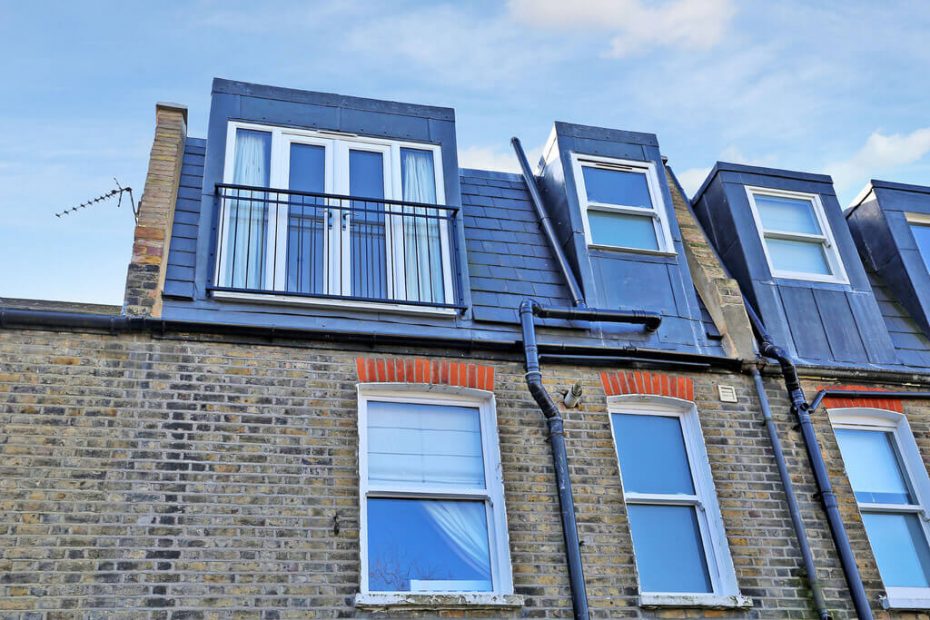Loft conversions are a great way to extend your property, creating a beautiful new space to utilize, without having to extend the footprint of the home. If you’re planning to get a loft conversion, there’s a lot to think about. Budget, builders, timescales, and project managers – there’s an endless list of considerations when it comes to this important home renovation. Whilst we can’t answer all your loft conversion questions today, we can give you a really handy heads up on the kinds of loft conversions that are available. This information will help you get a head start on your renovation research, getting you much closer to choosing the right types of loft conversions for your family home:
The Main Types of Loft Conversions
There are main loft conversion types on offer in the UK, each with its own pros and cons to consider. Let’s take a closer look at each type and what it has to offer:
Dormer

Source: hzcdn.com
A dormer loft conversion is a cost-effective, simple loft conversion type. It works by projecting the space vertically from the part of the roof that slopes down, a design that commonly gets accepted under ’permitted development’ laws.
It can be built in multiple different ways depending on the building type and planning permission.
Another standout feature of the dormer is the lack of roof windows, which is more common with other types of conversion. Instead, windows are on the side of the extension, and might even be floor to ceiling in style.
For more space, you can opt for a double dormer, which utilizes both sides of the roof, creating a dual extension that makes the most of the loft space.
Dormers are also useful for L-shaped loft conversions because the dormers can be joined in the center.
Additionally, there is something called a gabled dormer, which is commonly more expensive than a flat dormer. It has a pitched roof instead of a flat roof and is often considered more aesthetically appealing than a flat dormer, depending on your taste.
Dormers can also be combined with a hip-to-gable conversion by first raising the side sloping roof, which will then allow for adding the rear dormer to extend the full width.
Pros:
- Budget-friendly
- Often permitted without planning permission
- Adds lots of extra headroom
- Flat ceilings/ flat walls (no crooked spaces)
- Adds potential for Juliet balcony, roof lights, and floor to ceiling glass
Cons:
- Some consider it to be less aesthetically pleasing than other conversion types
- May not be as ‘light and bright’ as other conversions
Mansard

Source: hzcdn.com
A Mansard loft conversion is similar to adding a dormer conversion except for a few key differences. It can often be seen as a way to add an entire level to a house, usually making it a more expensive option. It suits terraced house loft conversions and Victorian houses but can be an option for many types of buildings.
It works by changing the roof structure of a sloping roof so that the walls are adjusted to become near vertical (unlike a dormer which IS vertical and simply ‘cuts’ a section from the roof). The conversion sits between gable walls and a flat roof sits on top, with roof windows added. Mansard loft conversions can be added to the side, front, and rear of houses and can be doubled up, depending on the type of property you have.
As with the dormer conversion type, you can also have an L-shaped Mansard loft conversion.
Pros:
- Creates lots of space
- Ideal if you want en-suites in your conversion
- Creates a beautiful, bright space
Cons:
- Party wall will need raising
- Tends to cost more than alternative conversion types
- Takes longer than some conversion types
- Will likely require planning permission
Skylight Conversion

Source: opun.co.uk
A skylight conversion is often very budget-friendly because the space itself is not changed with any complex new constructions. Instead, high-quality roof windows are added, in addition to plumbing, floor reinforcement, stairs, insulation, and electrics. It can work well for very small loft conversions or for loft bedrooms.
Pros:
- Very budget-friendly
- Let’s a natural light flood in
- Adds extra ventilation
- Minimally disruptive construction
- Usually does not need planning permission
Cons:
- Stairs may need to be in the center of the room because of headroom challenges
- Can still require planning permission
Also Read: What To Keep In Mind While Converting Your Loft
Hip to Gable

Source: pinimg.com
Hip to gable loft conversions work by removing the hipped roof part so instead, the roofline is changed and extended, and the loft floor space is maximized. Often, a window is added to bring in more natural light and ventilation to the new conversion space.
Pros:
- Great for end-of-terrace, detached and semi-detached properties
- Adds more space than a side dormer
- Converts the roofline so the loft has more workable space
Cons:
- More complex than regular mansard or rear dormer conversions
- Can cost more than other conversion types
The type of conversion that you can have depends heavily on your preference, budget, building type, and the planning permission you need. By using a trusted loft conversion company like Clapham Construction Service you can discuss the details and discover which of the above conversions are right for you.
Which Loft Conversion Type Will You Choose?
Although it can be challenging choosing a loft conversion design, ultimately, it’s really exciting because the end result is a beautiful new extension to your home that both increases its functionality and value.
Soon enough, you’ll be enjoying your very own Dormer, Skylight, Mansard, or other loft conversion design for a bigger, better home that provides a wide range of benefits for your family.
